Hoque. Advanced Applications of Rapid Prototyping Technology in Modern Engineering
Подождите немного. Документ загружается.


Usage of Rapid Prototyping Technique
in Customized Craniomaxillofacial Bone Tissue Engineering Scaffold
101
[20] Cho YR, Gosain AK. Biomaterials in craniofacial reconstruction. Clin Plast Surg
2004;31:377-385
[21] Baker SB, Weinzweig J, Kirschner RE, et al. Applications of a new carbonated calcium
phosphate bone cement: early experience in pediatric and adult craniofacial
reconstruction. Plast Reconstr Surg 2002;109:1789-1796
[22] Muhitdin E, Mustafa S, Murat T, et al. Contour restoration of the secondary
deformities of zygomaticoorbital fractures with porous polyethylene implant. J
Craniofac Surg 2007;18:520-525
[23] Menderes A, Baytekin C, Topcu A, et al. Craniofacial reconstruction with high-density
porous polyethylene implants. J Craniofac Surg 2004;15:719-724
[24] Mohamed ED, Tompach PC, Morstad AT, et al. Long-term follow-up of the use of
nonporous hydroxyapatite for augmentation of the alveolar ridge. J Oral
Maxillofacial Surg 1991;49:257-261
[25] Habal MB, Reddi AH. Bone grafts and bone induction substitutes. Clin Plast Surg
1994;21:525-529
[26] Hashem FK, AI Homsi M, Mahasim ZZ, et al. Laryngotracheoplasty using the Medpor
implant: an animal model. J Otolaryngol 2001;30: 334-339
[27] Gosain AK, Song L, Riordan P, et al. A 1-year study of osteoinduction in
hydroxyapatite-derived biomaterials in an adult sheep model: part I. Plast Reconstr
Surg 2002;109:619-630
[28] Gosain AK, Song L, Riordan P, et al. A 1-year study of osteoinduction in
hydroxyapatite-derived biomaterials in an adult sheep model: part II.
Bioengineering implants to optimize bone replacement in reconstruction of cranial
defects. Plast Reconstr Surg 2004;114:1155-1163
[29] Gosain AK, Song L, Riordan P, et al. A 1-year study of hydroxyapatite-derived
biomaterials in an adult sheep model: III. Comparison with autogenous bone graft
for facial augmentation. Plast Reconstr Surg 2005;116:1044-1052
[30] Schliephake H, Neukam FW. Bone replacement with porous hydroxyapatite blocks
and titanium screw implants: an experimental study. J Oral Maxillofacial Surg
1991;49:151-156
[31] Durham S, McComb J, Levy M. Correction of large cranial defects with reinforced
hydroxyapatite cement: technique and complications. Neurosurgery 2003;52:842-
845
[32] Xu Y, Dong T, Xu X, et al. Design and fabrication of EH composite material and
evaluation of its biomechanical properties. Acta Acad Med Zuzou 1995;15:17-18
[33] Fan X, Zhang D, Feng S, et al. Late reconstruction and repositioning of enophthalmos
of orbital blow-out fracture. China J Ophthalmol 2002;38:644-647
[34] Mu X, Dong J, Wang W, et al. Epoxide acrylate maleic resin and hydroxyapatite
composite material as a hone graft substitute in surgical correction of orbital
reconstruction. China J Ophthalmol 1995;31: 447-449
[35] Zins JE, Moreira-Gonzalez A, Papay FA. Use of calcium-based bone cements in the
repair of large, full-thickness cranial defects: a caution. Plast Reconstr Surg
2007;120:1332-1342
[36] Matic DB, Manson PN. Biomechanical analysis of hydroxyapatite cement cranioplasty.
J Craniofac Surg 2004;15:415

Advanced Applications of Rapid Prototyping Technology in Modern Engineering
102
[37] Bianchi SD, Ramieri G, De Gioanni PP, et al. The validation of stereolithographic
anatomical replicas: the authors' own experience and a review of the literature [in
Italian]. Radiol Med 1997;94:503-510
[38] Choi JY, Choi JH, Kim NK, et al. Analysis of errors in medical rapid prototyping
models. Int J Oral Maxillofac Surg 2002;31:23-32
[39] Matic D, Phillips JH. A contraindication for the use of hydroxyapatite cement in the
pediatric population. Plast Reconstr Surg 2002;110:1-5
7
Use of Rapid Prototyping and 3D
Reconstruction in Veterinary Medicine
Elisângela Perez de Freitas
1
, Pedro Yoshito Noritomi
2
and Jorge Vicente Lopes da Silva
2
1
Department of Veterinary Surgery and Anesthesiology,
College of Veterinary Medicine and Animal Science
– São Paulo State University (UNESP)
2
Tridimensional Technologies Division,
Renato Archer Information Technology Center (CTI)
Brazil
1. Introduction
1.1 Medical image processing
In veterinary medicine, as well as in medicine, many noninvasive image techniques have
been used for pathology diagnosis. The most oftenly used methods are computed
tomography (CT) and magnetic resonance imaging (MRI) (Lim & Zein, 2006). In general,
these equipments generate a sequence of 2D images which make it difficult to display the
spatial relationship of the important structures (Qiu et al., 2004). The 2D images are digitally
stored in the international standard DICOM (Digital Imaging and Communications in
Medicine) file format simplifying the interoperability among different medical systems with
no extra costs for data conversion. This file format contains the necessary data for three-
dimensional (3D) reconstruction and patient information. Specifically developed
reconstruction software, based on these 2D DICOM files, can generate the correspondent 3D
models of the region of interest. By means of the software, internal and external anatomy
can be clearly shown, measured, highlighted, and segmented either simultaneously or
separately.
1.2 Rapid prototyping
Rapid prototyping is an additive process based on a computer controlled deposition of
layers of materials. It was first available a little more than two decades ago, to speed up and
facilitate solutions in automobile and aeronautical product development. In a few years it
started to be used in the medical field, for reconstructive surgery, helping surgeons with a
perfect replica of the anatomy of the patient. Nowadays, rapid prototyping is also known as
additive manufacturing and is widespread in many areas of knowledge.
A virtual model is electronically sliced and sent to the machine that deposits each layer at
a time. In the process to build a physical model from a virtual one many different
processes are present using polymeric materials in different forms such as liquids,

Advanced Applications of Rapid Prototyping Technology in Modern Engineering
104
powders, sheets, and filaments. Other materials such as metals, ceramics, and paper can
also be used. To glue each layer on top of the other there are processes based on lasers,
binders, extrusion, etc.
The advantage of RP technologies is their ability to produce complex 3D physical models
from a three-dimensional computer model (Geng et al., 2005). The main processes of rapid
prototyping are: Selective Laser Sintering (SLS) based on the melting of a fine polymeric
powder by means of heating lasers; Estereolitography (SLA) that is based on the
polymerization of a liquid resin by means of specific wavelength lasers; Fused Deposition
Modeling (FDM) where a filament is extruded and deposited continuously in thin threads of
polymeric materials; and Tridimensional Printing (3DP) where each layer of powder is
glued to the upper by means of ink jetting a binder. There are available today about thirty
commercial processes including the above and its variations.
2. Veterinary clinical cases
2.1 Dogs: 3D model of different type of dog’s skull
Dogs are categorized as dolichocephalic (Doberman, Collie, Setter, Whippet), mesaticephalic
(Rottweiler, Poodle, Cocker spaniel) and brachycephalic (Boxer, Bulldog, Pug). The
mandibular structure can be different according to the type of dog’s skull. This mandibular
structure may vary in three ways: on the cortical bone’s width of the mandibular body,
mandibular size in relation to the maxilla or the type of dental occlusion in these animals. It
is really important that the surgeon is knowledgeable about the specifics of each kind of
dog, in order for him to choose the best surgical technique for the mandible fracture or
orthognathic corrections, then to re-habilitate occlusion and masticatory function, to make
them the closest to normal function as possible. This study has the goal to offer mandibular
images in a normal pattern of Doberman, Rottweiler, Poodle and Boxer so that they can help
as comparison tools between normal or affected structures. The animals were anesthetized
and physical examination indicated no abnormalities in the mandible. Sequential transverse
images of each dog’s head were acquired on a helical CT Scanner (Shimadzu SCT-7800CT).
The data obtained was saved in DICOM file format. 3D reconstructed images of the
mandible were made by software programs commercially available. The virtual models
were used to perform the measurements of length, height and width of the mandible and
measurements of the cortical bone of the mandible body. The results are described in Table 1
and Figure 1, 2.
Dog breed
Cortical bone (mm)
Length (mm) Height (mm) Width (mm)
Doberman 4,3 185,8 28,3 11,8
Rottweiler 5,2 162,8 27,2 19,5
Poodle 2,7 77,0 10,2 7,9
Boxer 4,7 137,7 20,8 11,6
Table 1. Measurements of the mandible for the different dog breeds.
This study has the goal to build the 3D reconstructed model of the mandible in a normal
pattern of Doberman, Rottweiler, Poodle and Boxer so that they can help as comparison
tools between normal and affected structures.
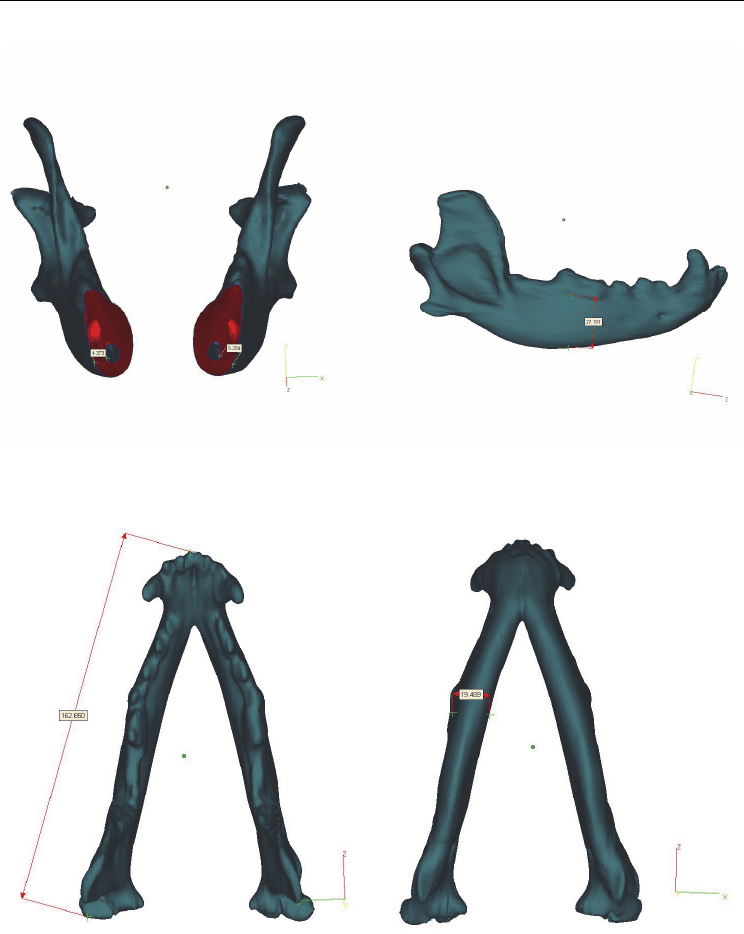
Use of Rapid Prototyping and 3D Reconstruction in Veterinary Medicine
105
Fig. 1. Measurements of the cortical bone and height of the Rottweiler’s mandible.
Fig. 2. Measurements of the length and width of the Rottweiler’s mandible.
2.2 Fox: orthopedic treatment of the maxillofacial malformation
A fox (Pseudalopex vetulus), 9-month-old free-ranging, 3.7 kg male was presented to the
Veterinary Hospital with Class II malocclusion – posterior cross-bite – on the right side
(Freitas et al., 2010a). The animal was anesthetized and oral examination revealed the right
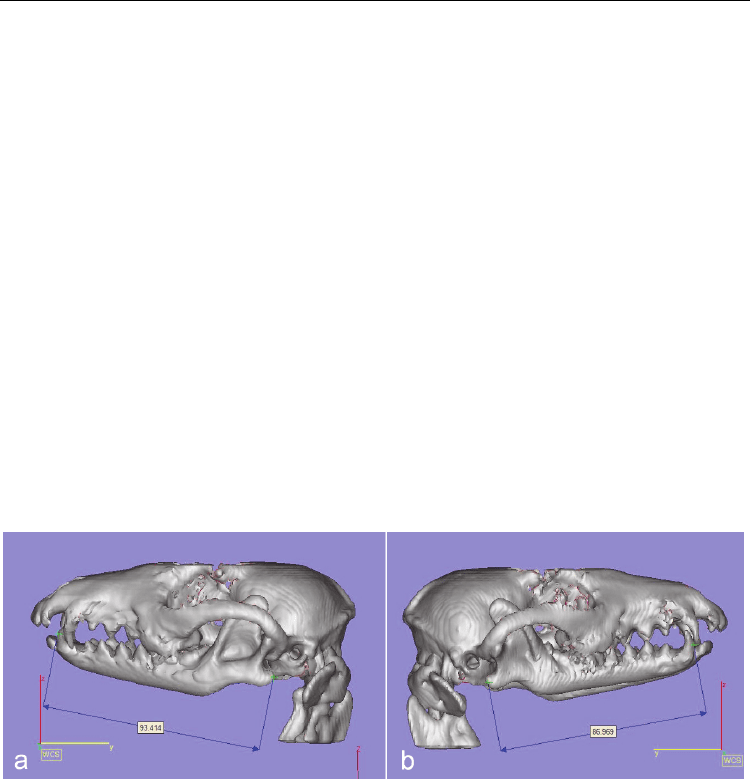
Advanced Applications of Rapid Prototyping Technology in Modern Engineering
106
mandibular canine tooth distal to the right maxillary canine tooth and tipped in a buccal
direction. Because of this, the left mandibular canine caused a lesion on the palate between
the left maxillary 3
rd
incisor and canine teeth. Sequential transverse images of the head were
acquired on a helical CT Scanner (Shimadzu SCT-7800CT) with the fox placed in dorsal
recumbency. The InVesalius software was also used to edit and measure the original 3D
virtual model obtained directly from the CT scan, and the Magics X SP2 was used to
generate the final model for the prototype machine. The virtual 3D model of the head
showed facial and mandibular asymmetry (Figure 3). The physical prototype constructed by
the 3DP (Z-Cortp) technique enabled the preoperative planning (Figure 4 and 5). The
inclined plane technique was used to correct crossbite and avoid palate injury. The fox
adapted well to the treatment showing signs of discomfort only in the first 48 h. The inclined
plane was removed after three months and a new CT exam was performed. Visualization of
3D images in combination with rapid prototyping allowed the surgeon to perform 3 sets of
geometric measurements in the virtual model on the first and second examination.
Comparison of the prototypes and oral examination confirmed less maxillofacial
discrepancy. Furthermore, the palate injury healed because the left mandibular canine tooth
was not making contact with the palatal tissues. This orthopedic treatment showed that the
Plana’s technique has satisfactory results while modifying the skeletal structure stimulating
the development of the stomatognatic system. In this case, the visualization and
segmentation of CT images and 3D reconstruction of skull aided the surgical planning. The
comparison of the prototype before and after treatment allowed a qualitative improvement
of the occlusion.
Fig. 3. Virtual 3D model (Magics X SP2) of the head based on CT image data showing the
left mandible (a) is bigger than the right mandible (b).
2.3 Rabbit: 3D finite element analysis
The finite element analysis (FEA) is one of the most promising tools in the study of
functional morphology of the craniofacial skeleton in humans and other species (Richmond
et al., 2005). It is a computationally intensive engineering technique that estimates how
objects of complex design resist loads (Wang et al., 2006). CT imaging is a useful method to
gather three-dimensional physiological data such as bone geometry and density in vivo
(Keyak et al., 1990). The results of von Mises’ stress distribution in a human model of
normal mandible showed that the model was reliable (Vollmer et al., 2000). Despite
advances in commercially available meshing programs for creating subject-specific models
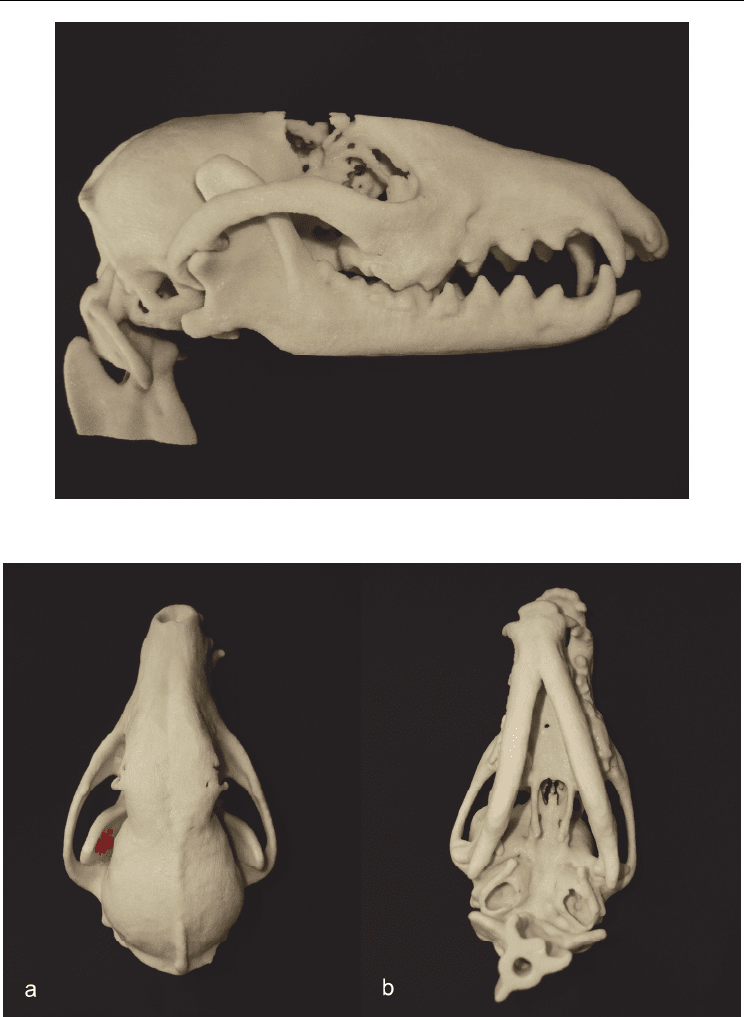
Use of Rapid Prototyping and 3D Reconstruction in Veterinary Medicine
107
Fig. 4. Photograph of the prototype of the fox’s skull.
Fig. 5. Photography showing dorsal (a) and ventral (b) view of the prototype. Note the
mandibular asymmetry.
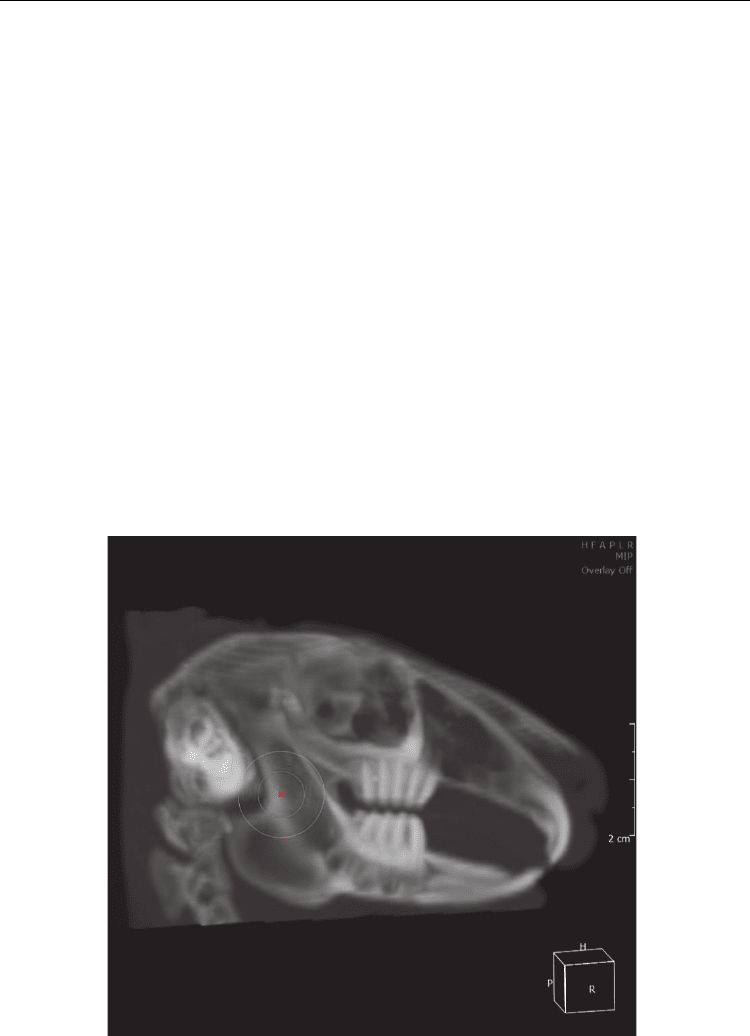
Advanced Applications of Rapid Prototyping Technology in Modern Engineering
108
from image data, the process is still expensive, in terms of time, and usually requires high
level of user intervention (Wilcox, 2007). In this study, three-dimensional (3D) geometrical
and finite element analysis (FEA) of the mandible of a rabbit were built in order to evaluate
the distribution of stresses on mandible of the rabbit applying a masticatory
force of 10 Newtons (N).
A computerized tomography (CT) examination was performed on the head of the Norfolk
rabbit, female, 2 months of age. In order to perform CT studies the animal was submitted to
general anesthesia. Sequential transverse images of the head were acquired on a helical
scanner (Shimadzu SCT-7800CT) with the rabbit placed in a dorsal recumbency. The
scanning parameters were 120kVp, 170 mA, 1.0 mm slice thickness, 1.0mm interval, pitch of
2.0, and 1 s/rotation (Figure 6). A virtual 3D model of the head was generated based on CT
image data, in DICOM (Figure 7). The 3D model was saved in STL format and it was
prototyped (Figure 8). The STL model was imported into the software Rhinoceros® in order
to create the BioCAD representation of the mandible prototype of the head was created. The
BioCAD was used as a reference to create a more complex 3D model, demanded by the
finite element analysis. The complete CAD models were exported to the NEiNastran®, finite
elements analysis program, using IGES file format. The finite elements analysis was
performed by using a tetrahedral elements mesh (Figure 9). Isotropic, linear and
homogeneous material properties were assumed for the bone. The study of total translation
distribution on mandible and opposite action of the masseter muscle had to be made by
NEiNastran® (Figure 10). The masticatory forces of the 10 N were applied on mandible in
order to simulate a typical rabbit bite.
Fig. 6. Image showing the reconstruction of the rabbit’s head.
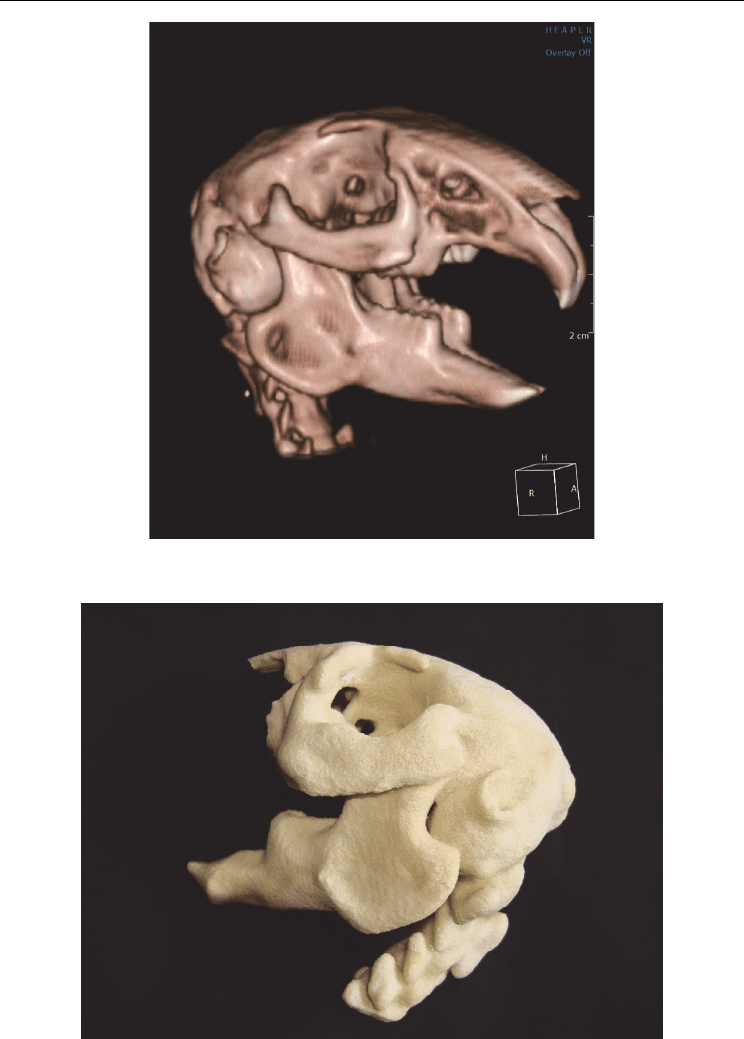
Use of Rapid Prototyping and 3D Reconstruction in Veterinary Medicine
109
Fig. 7. Image of the 3D virtual model of the rabbit’s skull.
Fig. 8. Photography of the rabbit skull prototype.
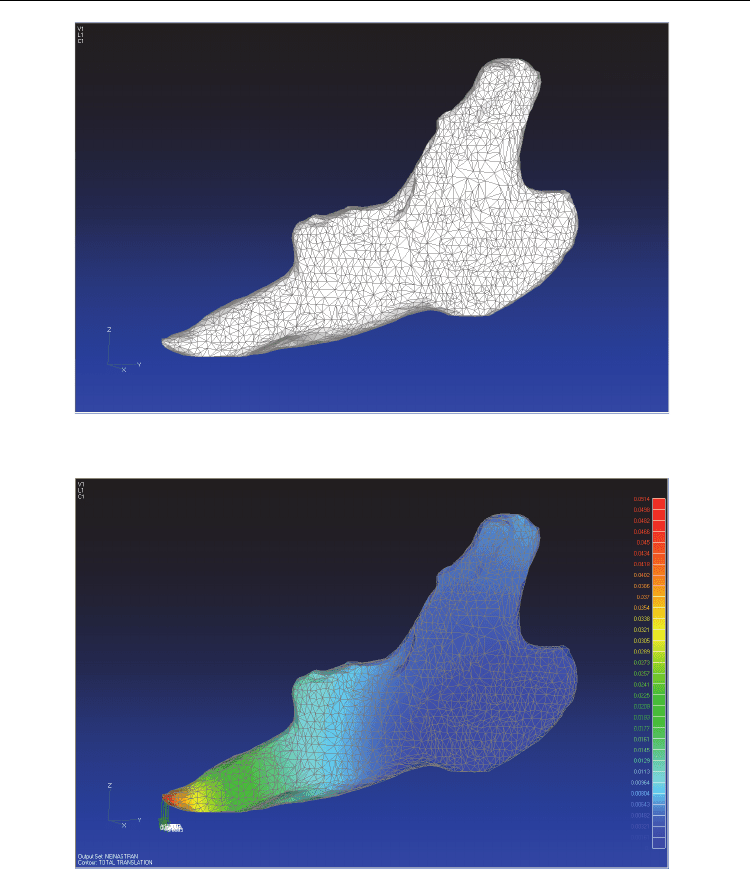
Advanced Applications of Rapid Prototyping Technology in Modern Engineering
110
Fig. 9. Finite element mesh on the rabbit’s mandible.
Fig. 10. Total translation distribution on the rabbit’s mandible.
The FEA has show von Mises’ stress concentration for the rabbit’s mandible. There was a
major von Mises’ stress concentration on the cranial region of the mandible (Figure 11), with
compressive stress propagation on the ventral side of the mandibular canal, with a tractive
stress on the dorsal side of the same mandibular canal, on the third middle of the
mandibular body. Both, the compressive and tractive stress fields follow through the
mandibular body, drawing a stress triangle with the vertical ramus of the mandible on
retro-molar region.
